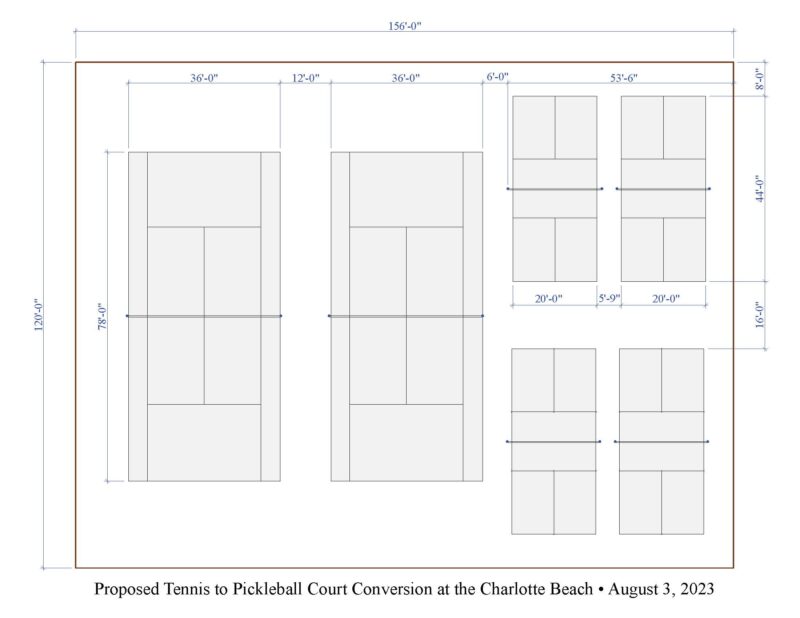Pickleball players push for more town beach courts

For three consecutive years, the Sports & Fitness Industry Association has named pickleball America’s fastest-growing sport. Charlotte doesn’t appear to be an exception to the rule, and there’s power in numbers.
Recently, local pickleball players have organized themselves to use it. This Monday, Aug. 7, at a meeting of the Charlotte Recreation Commission, they packed the town hall to support a proposal to turn one of the three tennis courts at the town beach into four permanent, full-time pickleball courts.
“I can say we are breaking our record,” chair Juliann Phelps told the teeming room.
But tennis players pushed back — not against the conversion itself, but against the picklers’ suggested design, which they worried would crowd one of the two remaining tennis courts, impacting their play and risking injury. By their judgment, two pickleball courts could fit comfortably on what is now the westernmost tennis court.
In the end, the rec commission split the difference, advising three regulation pickleball courts on the site. The recommendation will go to the selectboard for final approval.
The commission didn’t arrive at the compromise easily. An hour and a half of testimony and debate followed their perusal of a detailed plan submitted by resident Steven Wisbaum and co-signed by 42 other Charlotters, several of whom wrote testimonials about their love of pickleball and the need for dedicated facilities.
Wisbaum estimated that, already, the town beach hosts more than 10,000 hours of pickleball play annually. The picklers bring portable nets to the two tennis courts that bear overlapping markings for their sport. They hope to see the tennis courts remain usable for both games.
The selectboard has already hired a contractor to resurface all three courts later this month. It would cost extra to add new pickleball lines and nets, but the pickleball community has promised to donate enough cash to cover the difference.
Wisbaum’s proposal anticipated that tennis players would object on the basis of overcrowding. It acknowledged that the pickleball conversion would shrink the buffer on the western side of the middle tennis court from 12 feet to 6 feet, but it included a message of support from Charlotte’s contractor, Advantage Tennis, and an image of Rossignol Park in Williston, where the gap between the pickleball courts and the tennis court is, by Wisbaum’s measurements, even smaller.
“I encourage all of us to see this proposal not in terms of pitting the pickleball community against the tennis community,” Wisbaum said, “in part because many people who are in the pickleball community were or still are tennis players, including myself, but also because the pickleball community is simply asking the rec commission and the selectboard to acknowledge that the beach courts have become a multi-use facility.”
David Raymond, however, recognized a measure of conflict between the groups.
“It is a fact that these courts were underused up until maybe three years ago, when this group really started gathering,” said Raymond, a pickleball player. “And quite honestly, very unfortunately, it’s bothering tennis players all over the world that we are moving into their area, if you will. But these are rec courts, not truly tennis — they’re designed for tennis originally, but they’re owned by the town.”
Katie Taylor, a tennis player, denied any animosity.
“I think we’re trying to be acquiescent to the craze that is pickleball,” Taylor said. “I’m not speaking for all tennis players, but I think we’re happy to forgo one court for two pickleball courts, as long as it makes the second and third courts that get resurfaced playable.”
Matt Bastress, who also plays tennis, agreed with her.
“This proposal essentially leaves one court,” Bastress said. “I would love to see kids who are learning to play tennis continue to have access to tennis courts nearby. I’m just concerned that this really eliminates that to a great degree.”
But Wisbaum stressed that the town shouldn’t waste the site by building fewer pickleball courts than it could accommodate. He urged the commission to table the four-court proposal for future consideration, if it came to that, rather than approve a two-court design.
That’s nearly what happened. Recreation commissioner Robin Reid opined that the pickleball idea warranted consideration as an independent proposal, not as a “last-minute” addendum “tagging onto a maintenance project.” Her colleague Elisa Miller lamented that the tennis community hadn’t had as much time to respond to the pickleball plan as the pickleball community had had to create it.
But Craig Reynolds counseled his fellow commissioners to “stop kicking the can down the road.” He put forward a motion that borrowed from selectboard member Frank Tenney, who, from the audience, had raised the notion of building three pickleball courts instead of four (or two).
That way, just one pickleball court, instead of two, would border the middle tennis court. And it could be aligned in such a way as to minimize the chance of collision or interference, at least in theory.
The motion passed on a 4-2 vote. But that doesn’t necessarily mean it’ll pass twice.
“This is, again, just a recommendation,” Phelps warned. “So, the selectboard could just say, ‘I’m sorry, but we’re not allowing any more money outside of the request for proposal. The work is just being done as is.’ That could be a likely outcome. I just want people to be prepared for that.”

